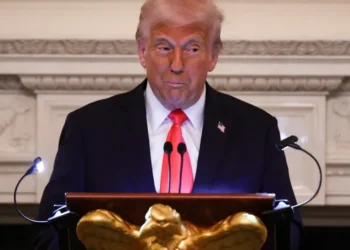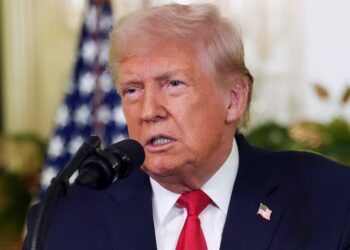In its diplomacy about the war, Kyiv has striven to maintain an axiom that great powers should not discuss the country’s fate over its head. “Nothing about Ukraine without Ukraine,” had been the approach.
Now, as the Trump administration has negotiated a 28-point settlement plan in just this way — with input from Russia but not from Ukraine or from its allies in Europe — Ukrainian and European officials and commentators are responding with dismay.
“For any plan to work, it needs Ukrainians and Europeans on board,” Kaja Kallas, the European Union’s top diplomat, said on Thursday ahead of a meeting of the bloc’s foreign affairs council.
Some in Ukraine said they believed that the United States was moving to force a settlement after Kyiv’s recent setbacks on the battlefield and amid the weakening of the government of President Volodymyr Zelensky in a corruption scandal.
But those talks without Ukraine came with questions. It was not clear whether those speaking for Washington and for Moscow had the full authority of their governments. The Trump administration is pursuing multiple streams of diplomacy at once, leaving some in Ukraine to wonder how they fit together. And the Kremlin has deflected questions about the peace plan.
Ukrainian officials say they have seen parts of the 28-point proposal, which was negotiated between Steve Witkoff, a Trump administration envoy, and a Kremlin counterpart, Kirill Dmitriev. As a condition for peace, it proposes that Ukraine surrender territory, cap the size of its army, forgo the deployment of a postwar Western peacekeeping force and relinquish long-range weapons. The plan revives maximalist Moscow demands that Kyiv has previously rejected.
News of the proposal came on the same day that a Russian missile struck an apartment block in the western Ukrainian city of Ternopil, killing at least 26 and wounding about 90 others, officials said. Rescue operations continued for a second day on Thursday, with 22 people still missing, Mr. Zelensky said.
Asked about the settlement plan on Thursday, Dmitri S. Peskov, the Kremlin spokesman, said that Moscow had not proposed any new terms for a settlement after President Vladimir V. Putin met with President Trump in Alaska in August. On Wednesday, Stephen Miller, a White House deputy chief of staff, said he had no announcements to make about the plan.
A U.S. military negotiating team, which was not involved in the 28-point proposal by Mr. Witkoff and Mr. Dmitriev, was in Kyiv, the Ukrainian capital, on Thursday for talks. Mr. Trump’s decision to send the delegation, led by Dan Driscoll, the Army secretary, to help restart peace talks reflected a belief that the Kremlin might be more receptive to military-brokered negotiations.
That diplomatic track is the third one opened by the Trump administration. The other two have been led by Mr. Witkoff, the U.S. envoy for peace missions, and by Keith Kellogg, a former Army general who is Mr. Trump’s envoy to Russia and Ukraine.
Mr. Zelensky has thanked Mr. Trump for the efforts and has worked with multiple officials. Still, an adviser in his government on foreign policy, who spoke on the condition of anonymity to discuss sensitive diplomacy, said confusion had arisen.
On a recent visit to Washington, the adviser said, he was assured that the Trump administration would seek a settlement in Ukraine before opening significant talks on broader issues, including a thaw in relations with Russia.
But it was the adviser’s understanding that the 28-point plan included provisions addressing broader matters on Russia as well as on European security, alongside provisions to end the war in Ukraine. He said it was unclear whether the plan had full support in Washington.
Another senior Ukrainian official, who asked not to be named to discuss internal matters, said on Wednesday that the Trump administration had informed Kyiv of the talks on the 28-point plan but had not sought its input. The official said that the Ukrainian government objected to the proposal’s terms.
Secretary of State Marco Rubio said on social media on Wednesday that the administration would develop a “list of potential ideas for ending this war that would be based on input from both sides of this conflict.” He added that “a durable peace will require both sides to agree to difficult but necessary concessions.”
Ms. Kallas, the E.U diplomat, said on Thursday that the Europeans had not heard about any Russian concessions in the 28-point plan.
Senior European leaders recoiled at the U.S.-Russian plan after aspects of it were reported.
The Dutch foreign minister, David van Weel, said that any settlement was “about Ukrainian territory. It’s about Ukrainian sovereignty. So without a buy-in of Ukraine, you won’t get the support of the Europeans.”
The Swedish foreign minister, Maria Malmer Stenergard, said, “It’s quite obvious that Russia is not willing to have serious peace talks.” She called for unlocking Russian assets that have been frozen in Europe to put much-needed pressure on Moscow in negotiations.
“There can be no peace without Ukraine, and Europe has to be at the table,” she added. “There are a lot of talks about different talks.”
Ivan Nechepurenko contributed reporting from St. Petersburg, Russia.
Andrew E. Kramer is the Kyiv bureau chief for The Times, who has been covering the war in Ukraine since 2014.
The post Ukraine and Europe Chafe at Being Excluded From U.S.-Russian Peace Plan appeared first on New York Times.




